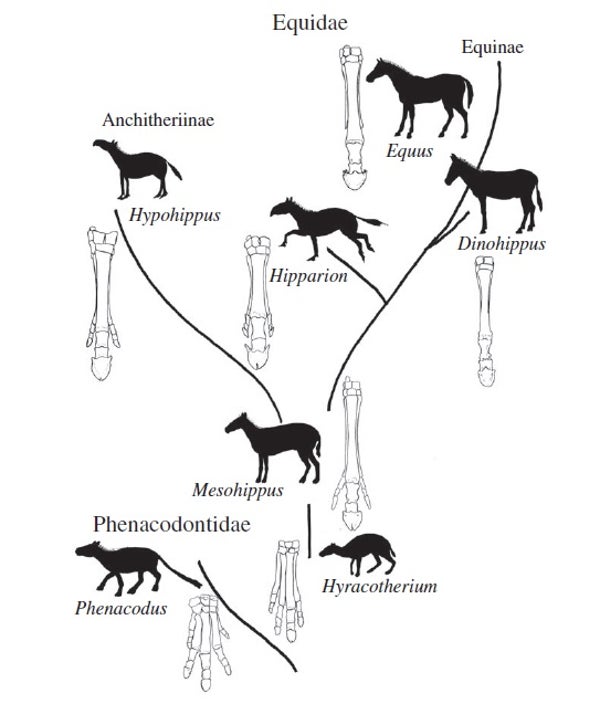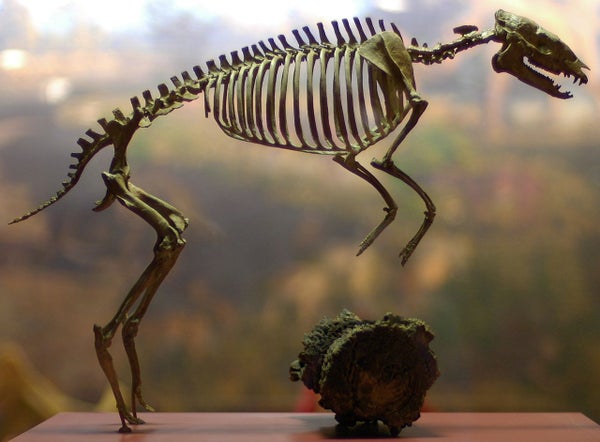This article was published in Scientific American’s former blog network and reflects the views of the author, not necessarily those of Scientific American
Horses are on point. This is literally true. From asses to zebras, all living horses stand on a single toe - the equivalent of our third digits of our hands and feet.
The singular nature of horse legs has made equids evolutionary favorites. Their fossil record is so extensively known that for over a century they have been icons of transcendent change, a tangle of petrified skeletons stretching back over 50 million years documenting how tiny, forest-dwelling species like Eohippus scampered around on multiple toes until life on hard, grass-covered plains nudged horses towards their more familiar modern forms.
Modern horses carry some signs of these changes. Now and then a horse is born with vestigial side toes, demonstrating that the genetic and developmental framework for those additional digits still exists. And even in horses with the expected single hoof, the front legs still bear two tapered bones on the side of the primary column of the feet - split bones - that are remainders of ancient, additional toes.
On supporting science journalism
If you're enjoying this article, consider supporting our award-winning journalism by subscribing. By purchasing a subscription you are helping to ensure the future of impactful stories about the discoveries and ideas shaping our world today.
This is textbook stuff, an easily-accessible demonstration of how every organism is a mix of the old and new. But we’ve apparently been missing other clues wrapped in equine flesh. Horses don’t just have parts of three toes. They retain signs of the standard mammalian complement of five digits.

A rough outline of horse foot evolution. Credit: Solounias et al 2018
Anatomist Nikos Solounias and colleagues
found the long lost piggies. It wasn’t as simple as just taking another look at a modern horse. Evolutionary context was needed, earlier horses such as the four-toed Eohippus, three-toed Mesohippus, and single-toed Dinohippus providing background and fetal horse specimens allowing insights into development. In the end, the researchers not only found the “missing” digits but changed the anatomical map of the horse foot.
As far as the front legs go, Solounias and coauthors point out, the traditional structure largely holds. Horses stand on their third finger, with the lateral splints being remnants of fingers two and three. But each of those splints have ridges on the bottom sides, which the experts suggest are the remainders of the lost digits one and five (think your thumb and pinky).
The rear feet are a different story. There’s a specialized structure called the frog on the bottom of the back hoof that’s the remainder of the second and fourth toes. But there are more subtle structures - called “the wings and hoof cartilages” - that are the remnants of the first and fifth toes. The upshot, the researchers write, is that they “show shades of pentadactyly within the Equus manus.”
This alters the classic story of horse evolution. The traditional tale, which I helped perpetuate in my book
Written in Stone, was that ecological shifts spurred horses to reducing their digits to single columns. The remainders are just signs of what once was. But now Solounias and colleagues have revealed that the story of how horse feet came to be so strange might not be as dramatic as previously thought.
Even though horses primarily stand on their middle digits, they still have parts of all five ancestral toes present. More than that, the researchers point out, the position of each part of the osteological quintet remain stable, consistent in their placement despite changes in size or shape over time. The foundation for horse forelimbs, at least, was set down by Eohippus in the Eocene and has just been tweaked this way or that in the time since. We can read the whole history of the horse through their feet, and it turns out their constellation of bones can take us back further in time than we ever expected.
